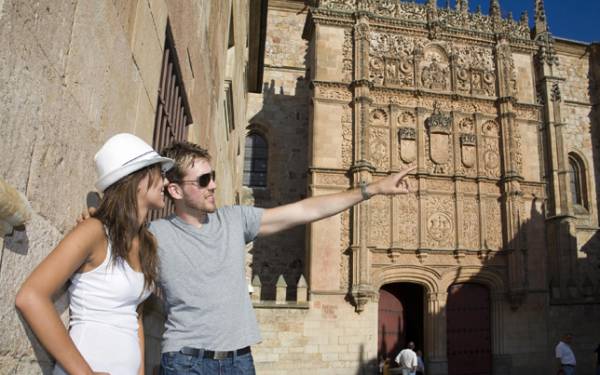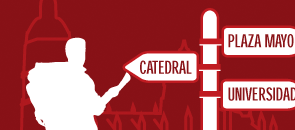There is no need to rush:
Plaza Mayor. Undoubtedly one of the most beautiful squares in Spain and in the world and one of the best examples of Baroque architecture in the Peninsula. Visit the Cathedrals, and don’t forget to climb the cathedral’s medieval towers via the Ieronimus exhibition: You can walk around the exterior terraces, the lookout points and balustrades that look over the interior of the church, amidst gargoyles, pinnacles and cathedral bells. The University’s Historic Building, the oldest in Spain, is also worth a visit, and it is traditional for tourists to try to find the frog on its façade. Inside, visitors can discover other wonders such as the Fray Luis lecture hall, where time appears to have stood still, or the Old Library. No rush, but make sure to see the Casa de las Conchas, renowned for its main façade which is covered with hundreds of shells, and la Clerecía Church and the Pontifical University, located just opposite. And don’t forget to climb the La Clerecía Towers and enjoy some spectacular views over the city from the tower balconies, a breathtaking vantage point.
After this pleasant walk, time for a quick break to get our strength back. There are some excellent restaurants with top-quality dining. Traditional and avant-garde cuisine with locally-grown products, featuring mouth-watering dishes such as Guijuelo cured ham, “morucha” beef, lentils from Armuña, chanfaina (rice with a chorizo and pork stew), roasts…locally-produced Salamanca cheeses, olive oils and wines. How about fine dining with views over the city (Parador de Turismo) or in the Plaza Mayor, or even in a contemporary art centre or how about in a traditional Castilian tavern.
Why not take a walk along the Roman Bridge or a stroll around the Calixto y Melibea Gardens, with their unique Muslim design. The Casa Lis is an impressive modernist building with stained glass and it is just one of the city’s treasures. It is home to the Art Nouveau and Art Déco Museum with an incredible collection of decorative art dating from the end of the 19th up to the early 20th century, which include the porcelain doll, bronze and marble figurine and glassware collections.
The city boasts a number of convents which boast huge cultural significance, especially those of San Esteban and of Las Dueñas. If visiting the latter, we suggest you try the pastries, home made by the nuns. Savour their delights as you peacefully sit in the cloisters, taking in the breathtaking views of the Cathedral.
And if you enjoy hearing about mysteries and legends, then a must-see is the Cueva de Salamanca, the Salamanca Caves, a magical place where it is said that the Devil used to give classes in the dark arts; and the Patio de la Salina, the former salt store.
The main dates on the cultural calendar are Easter, lunes de aguas (Water Monday), the Castile-and-Léon Arts Festival (June) the San Juan de Sahagún Festival (12 June), the Fairs and Festivals in September and the Mariquelo climb up the cathedral Tower (31 October).












